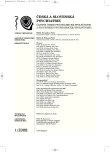The Use of Coercion in Psychiatry - Results of the International Project EUNOMIA, basic Characteristics of the Final Cohort in the Czech Republic
Authors:
doc. MUDr. Lucie Kališová, Ph.D. 1; J. Raboch 1; L. Číhal 1; I. Novotná 2; E. Kitzlerová 1; Skupina Eunomia 1,2
Authors‘ workplace:
Psychiatrická klinika 1. LF UK a VFN, Praha
; přednosta prof. MUDr. J. Raboch, DrSc.
Psychiatrická léčebna Bohnice, Praha
1; ředitel MUDr. I. David, CSc.
2
Published in:
Čes. a slov. Psychiat., 104, 2008, No. 1, pp. 4-8.
Category:
Original Article
Overview
EUNOMIA international project (European Evaluation of Coercion in Psychiatry and Harmonisation of Best Clinical Practice) focusing on the use of coercive measures in psychiatry proceeded from 2002 till 2006. In the first part of the results presentation put forward general description of the project and main clinical and sociodemographic characteristics of the national set of patients.
Key words:
coercive measures, sociodemographic characteristics, clinical characteristics.
Sources
1. Baudiš, P., Kališová, L., Kitzlerová, E., Petr, T., Miklóš, T.: Omezovací prostředky. In. Raboch et al.: Psychiatrie. Doporučené postupy psychiatrické péče II. Infopharm, 2007, s. 152–163.
2. Bruns, G.: Compulsory patients admission – a psychiatric risk group. Nervenarzt, 62, 1991, 5, pp. 308-312.
3. Cougnard, A., Kalmi E., Desage, A. et al.: Factors influencing compulsory admission in first-admitted subjects with psychosis. Soc. Psychiatry Psychiatr. Epidemiol., 39, 2004, 10, pp. 804-809.
4. Crisanti, A. S., Love, E. J.: Characteristics of psychiatric inpatients detained under civil commitment legislation: a Canadian study. Int. J. Law Psychiatry, 24, 2001, 4-5, pp. 399-410.
5. Davies, S., Thornicroft, G., Leese, M. et al.: Ethnic diferencies in risk of compulsory psychiatric admission aminy representative CASE of psychosis in London. BMJ, 321, 1996, pp. 533-537.
6. Gardner, W., Hoge, S., Bennett, N., Roth, L., Lidz, C., Monahan, J., Mulvey, E.: Two scales for measuring patients’ performance perceptions of coercion during hospital admission. Behavioral Sciences and the Law, 20, 1993, pp. 307-321.
7. Kališová, L., Raboch, J., Kitzlerová, E., Novotná, I.: Obecná praxe užívání omezovacích opatření – monitorování situace v České republice. Čes a slov Psychiat., 101, 2005, 6, s. 303-307.
8. Kališová, L., Raboch, J., Novotná, I., Černý, M., Victorínová, K., Kitzlerová, E., Nawka, A., Chudárek, F.: Užití omezovacích opatření a prostředků v psychiatrii – mezinárodní projekt EUNOMIA. Čes a slov. Psychiat., 100, 2004, 7, s. 420–427.
9. Kallert, T. W., Glöckner, M., Onchev, G., Raboch, J., Karastergiou, A., Solomon, Z., Magliano, L., Dembinskas, A., Kiejna, A., Nawka, P., Torres-Gonzáles, F., Priebe, S., Kjellin, L.: The EUNOMIA project on coercion in psychiatry: study design and preliminary data. World Psychiatry, 4, 2005, 3, pp. 168-172.
10. Kelly, B. D., Clarke, M., Browne, S. et al.: Clinical predictors of admission status in first episode schizophrenia. Eur Psychiatry, 19, 2004, 2, pp. 67-71.
11. Leung, P. K., Faulkner, L. R., McFarland, B. H., Riley, C.: Indochinese patients in the civil commitment process. Bull. Am. Acad. Psychiatry Law., 21, 1993, 1, pp. 81-89.
12. Metodické opatření Ministerstva zdravotnictví ČR k používání omezovacích prostředků u pacientů v psychiatrických zařízeních České republiky. Věstník MZ č. 1/2005.
13. Michalon, M., Richman, A.: Factors affecting length of stay in a psychiatric intensive care unit. Gen. Hosp. Psychiatry, 12, 1990, 5, pp. 303-308.
14. Nicholson, R. A.: Characteristics associated with change in the legal status of involuntary psychiatric patients. Hosp. Community Psychiatry, 39, 1988, 4, pp. 424-429.
15. Russo, J., Roy-Byrne, P., Jaffe, C. et al.: Psychiatric status, quality of life, and level of care as predictors of outcomes of acute inpatient treatment. Psychiatr. Serv., 48, 1997, 11, pp. 1427-1434.
16. Salize, H. J., Dressing, H.: Epidemiology of involuntary placement of mentally ill people across the European Union. Br. J. Psychiatry, 184, 2004, pp. 163-168.
17. Sanguineti, V. R., Samuel, S. E., Schwartz, S. L., Robeson, M. R.: Gender differences among civilly committed schizophrenia subjects. Schizophr. Bull., 22, 1996, 4, pp. 653-658.
18. Serper, M. R., Goldberg, B. R., Herman, K. G. et al.: Predictors of aggression on the psychiatric inpatient service. Compr. Psychiatry, 46, 2005, 2, pp. 121-127.
19. Singh, S. P., Croudace, T., Beck, A., Harrison, G.: Perceived ethnicity and the risk of compulsory admission. Soc. Psychiatry Psychiatr. Epidemiol., 33, 1998, 1, pp. 39-44.
20. Szmulker, G. I., Bird, A. S., Button, E. J.: Compulsory admissions in a London borough: I. Social and clinical features and a follow-up. Psychol. Med., 11, 1981, 3, pp. 617-636.
21. Tremblay, P. F., King, P. R., Baines, G. R.: Clinical and demographic characteristics of voluntary and involuntary psychiatric inpatients. Can. J. Psychiatry, 39, 1994, 5, pp. 297-299.
22. Tuohimaki, C., Kaltiala-Heino, R. et al.: Deprivation of liberty in Finnish psychiatric inpatients. Int. J. Law Psychiatry, 27, 2004, 2, pp. 193-205.
23. Ventura, J., Lucoff, D. et al.: Brief psychiatric rating scale (BPRS) expanded version (4.0) scales, anchor points and administration manual. Int. J. Metod. Psych. Res., 1993, 3, pp. 227-243.
Labels
Addictology Paediatric psychiatry PsychiatryArticle was published in
Czech and Slovak Psychiatry

2008 Issue 1
- Memantine in Dementia Therapy – Current Findings and Possible Future Applications
- Memantine Eases Daily Life for Patients and Caregivers
- Hope Awakens with Early Diagnosis of Parkinson's Disease Based on Skin Odor
- Deep stimulation of the globus pallidus improved clinical symptoms in a patient with refractory parkinsonism and genetic mutation
Most read in this issue
- Dopaminergic Mechanisms in Depression and Antidepressant Drug Effects
- Escitalopram in the Treatment of Atypical Depression: Eight Weeks Noninterventional Clinical Study in Routine Conditions of Ambulatory Practice
- Hoarding of Possessions and Animals
- Trouble with Causality: Contribution of Hallucinogens, Antidepressives and Isotretinoin to Development of Depression and the Suicidal Behaviour
